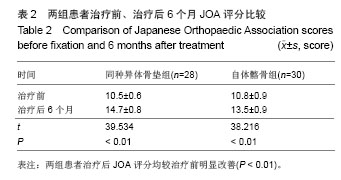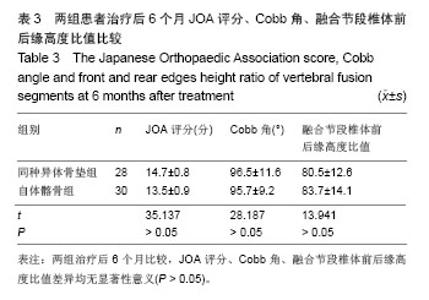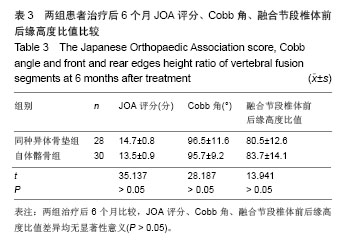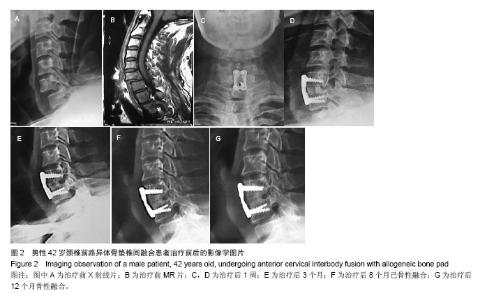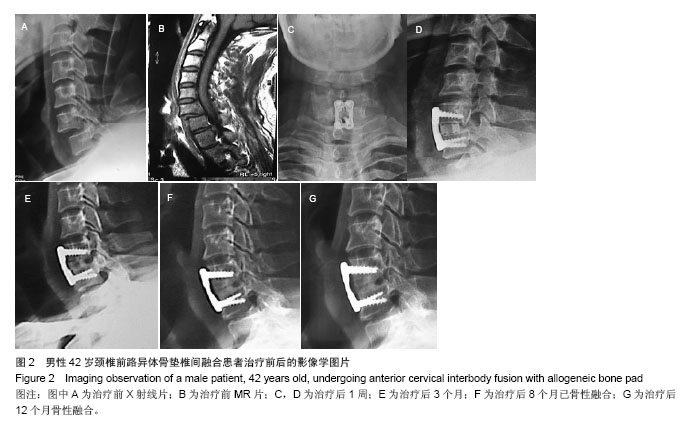Chinese Journal of Tissue Engineering Research ›› 2014, Vol. 18 ›› Issue (39): 6252-6257.doi: 10.3969/j.issn.2095-4344.2014.39.004
Previous Articles Next Articles
Comparative analysis of allogeneic bone pad and autogenous bone graft in anterior cervical interbody fusion
Wang Wei-ji, Guan Yu-cheng, Gao Xi-lin, Ji Ming-hua, Guo Shu-zhang, Fan Xiang-cheng, Ye Si-bo
- Department of Orthopedic Trauma, Urumqi General Hospital of Lanzhou Military Command, Urumqi 830000, Xinjiang Uygur Autonomous Region, China
-
Online:2014-09-17Published:2014-09-17 -
Contact:Ji Ming-hua, Associate chief physician, Department of Orthopedic Trauma, Urumqi General Hospital of Lanzhou Military Command, Urumqi 830000, Xinjiang Uygur Autonomous Region, China -
About author:Wang Wei-ji, Attending physician, Department of Orthopedic Trauma, Urumqi General Hospital of Lanzhou Military Command, Urumqi 830000, Xinjiang Uygur Autonomous Region, China
CLC Number:
Cite this article
Wang Wei-ji, Guan Yu-cheng, Gao Xi-lin, Ji Ming-hua, Guo Shu-zhang, Fan Xiang-cheng, Ye Si-bo. Comparative analysis of allogeneic bone pad and autogenous bone graft in anterior cervical interbody fusion[J]. Chinese Journal of Tissue Engineering Research, 2014, 18(39): 6252-6257.
share this article
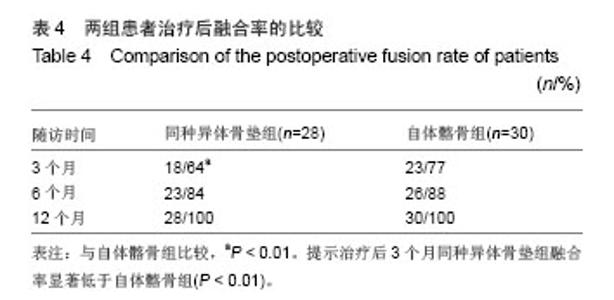
JOA评分在治疗前后差异具有显著性意义(P < 0.01),治疗后恢复良好。治疗后6个月两组JOA评分对比差异无显著意义(P > 0.05)。 采用自制异体骨垫与自体髂骨治疗后6个月比较,JOA评分、Cobb角、融合节段椎体前后缘高度比值差异均无显著性意义(P > 0.05)。 2.4 融合率 分别于治疗后即刻、3个月、6个月、12个月拍摄颈椎正侧位X射线片,半年后摄过伸过屈位X射线片。两组病例均在12个月之内原位融合。同种异体骨垫组与自体髂骨组治疗后3个月差异有显著性意义(P < 0.01),治疗后6个月差异无显著性意义(P > 0.05)。同种异体骨垫组明显较自体髂骨组融合时间长,虽骨垫最终融合率与自体髂骨无明显差别,但骨垫融合时间仍明显长于自体髂骨。见表4。"
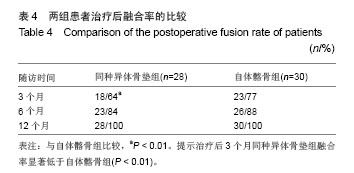
| [1]林坚平,宋世锋,黎早敏,等.自体骨髓移植复合人工骨治疗骨缺损[J].中国组织工程研究与临床康复,2011,15(26): 4891- 4894.
[2]丛宪玲,王金成,王亮,等.骨库的特点及发展趋势[J].中国组织工程研究与临床康复,2011,15(33):6235-6338.
[3]关玉成,贾勇,粱景灏,等.自制异体骨垫在颈椎融合术中的临床应用[J].西北国防医学杂志,2010,31(1):17-18.
[4]Vail Jonbergen HP, Spmit M, Anderson PG, et al.Anterior cervical interbody fusion with a titanium box cage:early radio logical assessment of fusion and subsidence. Spine. 2005; 30:646-649.
[5]周其佳,王谦.同种异体骨移植在基层医院的应用研究[J].医学理论与实践,2007,20(12):1388-1390.
[6]Njoku I Jr, Alimi M, Leng LZ,et al.Anterior cervical discectomy and fusion with a zero-profile integrated plate and spacer device: a clinical and radiological study. Neurosurg Spine. 2014:1-9.
[7]Davis RJ, Kim KD, Hisey MS,et al.Cervical total disc replacement with the Mobi-C cervical artificial disc compared with anterior discectomy and fusion for treatment of 2-level symptomatic degenerative disc disease: a prospective, randomized, controlled multicenter clinical trial: clinical article. J Neurosurg Spine.2013;19(5):532-545.
[8]程昌志,林舟丹.同种异体骨移植在颈椎前路融合手术中的应用[J].中国组织工程研究与临床康复,2007,11(43):8765-8769.
[9]Kim CH, Chung CK, Jahng TA,et al. Segmental Kyphosis after Cervical Interbody Fusion with Stand-alone Polyetheretherketone (PEEK) Cages: A Comparative Study on Two Different PEEK Cages. Spinal Disord Tech. 2014. [Epub ahead of print]
[10]杨进顺,廖壮文,范子文,等.一体成型式皮质骨生物型颈椎椎间融合器在颈前路融合术中的应用[J].中华创伤骨科杂志, 2010, 12(7):609-612.
[11]Lan X, Xu JZ, Luo F,et al. One-stage debridement and bone grafting with internal fixation via posterior approach for treatment of children thoracic spine tuberculosis. Zhongguo Gu Shang. 2013;26(4):320-3
[12]Nayak AN, Stein MI, James CR,et al. Biomechanical analysis of an interbody cage with three integrated cancellous lag screws in a two-level cervical spine fusion construct: an in vitro study.Spine. 2014. pii: S1529-9430(14)00574-9.
[13]王宣,申勇,张英泽.脊柱非融合技术的新进展及应用[J].中国矫形外科杂志,2008,16(19):1486-1489.
[14]朱永顺,王文军.颈椎非融合性固定的研究进展[J].中国矫形外科杂志,2007,15(5):362-363.
[15]杨成林,毕郑钢,曹阳,等.椎间撑开颈前路减压植骨钢板内固定术治疗脊髓型颈椎病[J].中国矫形外科杂志,2007,15(5):328-330.
[16]Caroli E,Orlando ER,Andrea G,et al.Anterior cervical fusion with interbody titanium cage containing surgical bone site graft:our institution’s experience in 103 consecutive cases of degenerative spondylosis. Spinal Disord Tech. 2007;20(3): 216-220.
[17]Fraser JF,Hartl R. Anterior approaches to fusion of the cervical spine:a metaanalysis of fusion rates. Neuro surg Spine.2007; 6(4):298-303.
[18]毕大卫,祖罡,陈亿民,等.不同颈前路椎体间融合固定术疗效评价的病例对照研究[J].中国骨伤,2008,21(6):419-421.
[19]Davis RJ, Kim KD, Hisey MS,et al.Cervical total disc replacement with the Mobi-C cervical artificial disc compared with anterior discectomy and fusion for treatment of 2-level symptomatic degenerative disc disease: a prospective, randomized, controlled multicenter clinical trial: clinical article. J Neurosurg Spine.2013;19(5):532-545.
[20]Zigler JE, Delamarter R, Murrey D,et al.ProDisc-C and anterior cervical discectomy and fusion as surgical treatment for single-level cervical symptomatic degenerative disc disease: five-year results of a Food and Drug Administration study. Spine (Phila Pa 1976).2013;38(3):203-209.
[21]Fraser JF,Hartl R.Anterior approaches to fusion of the cervical spine: a metaanalysis of fusion rates. Neuro surg Spine. 2007; 6:298-303.
[22]Scholz M,Schnake KJ,Pingel A,et al.A new zero-profile implant for standalone anterior cervical interbody fusion.Clin Orthop Relat Res.2011;469:666-673.
[23]Miller LE,Block JE.Safety and effectiveness of bone allografts in anterior cervical discectomy and fusion surgery. Spine (Phila Pa 1976). 2011;36:2045-2050.
[24]Vanek P, Bradac O, DeLacy P, et al. Comparison of 3 fusion techniques in the treatment of the degenerative cervical spine disease. Is stand-alone autograft really the "gold standard?": prospective study with 2-year follow-up. Spine (Phila Pa 1976). 2012;37(19):1645-1651.
[25]Jacobs W, Willems PC, Kruyt M, et al. Systematic review of anterior interbody fusion techniques for single- and double-level cervical degenerative disc disease.Spine (Phila Pa 1976). 2011;36(14):E950-960.
[26]Jacobs W, Willems PC, van Limbeek J,et al. Single or double-level anterior interbody fusion techniques for cervical degenerative disc disease. Cochrane Database Syst Rev. 2011;(1):CD004958.
[27]Buttermann GR.Prospective nonrandomized comparison of an allograft with bone morphogenic protein versus an iliac-crest autograft in anterior cervical discectomy and fusion. Spine J.2008;8:426-435.
[28]Daentzer D,Willbold E,Kalla K,et al.Bioabsorbable Interbody Magnesium-Polymer-Cage: Degradation Kinetics, Biomechanical Stiffness and Histological Findings from an Ovine Cervical Spine Fusion Model.Spine (Phila Pa 1976). 2014. [Epub ahead of print]
[29]Matz PG,Anderson PA,Holly LT,et al.The natural history of cervical spondylotic myelopathy.J Neuro Surg Spine.2009;11: 104-111.
[30]Yan D,Wang Z,Deng S,et al.Anterior corpectomy and reconstruction with titanium mesh cage and dynamic cervical plate for cervical spondylotic myelopathy in elderly osteoporosis patients.Arch Orthop Trauma Surg. 2011;131: 1369-1374.
[31]Amaral SH,Silva MN,Giraldi M,et al.Multiple cervical arcocristectomies for the treatment of cervical spondylotic myelopathy: surgical technique and results. J Neurosurg Spine. 2007;7:503-508.
[32]Hwang SL,Lee KS,Su YF,et al.Anterior corpectomy with iliac bone fusion or discectomy with interbody titanium cage fusion for multilevel cervical degenerated disc disease.J Spinal Disord Tech.2007;20:565-570.
[33]Azab W,Abdel-Razek M,Ali A,et al.Outcome evaluation of a zero profile implant for anterior cervical diskectomy with fusion. Turk Neuro surg.2012;22:611-617.
[34]Daentzer D, Floerkemeier T, Bartsch I,et al.Preliminary results in anterior cervical discectomy and fusion with an experimental bioabsorbable cage - clinical and radiological findings in an ovine animal model.Springerplus. 2013;2:418.
[35]Hussain M,Natarajan RN,Fayyazi AH,et al.Screw angulation affects bone-screw stresses and bone graft load sharing in anterior cervical corpectomy fusion with a rigid screw-plate construct: a finite element model study.Spine J. 2009;9: 1016-1023.
[36]Marawar S,Girardi FP,Sama AA,et al.National trends in anterior cervical fusion procedures.Spine (Phila Pa 1976). 2010;35:1454-459.
[37]Jiang SD,Jiang LS,Dai LY.Anterior cervical discectomy and fusion versus anterior cervical corpectomy and fusion for multilevel cervical spondylosis: a systematic review.Arch Orthop Trauma Surg.2012;132:155-161.
[38]Daniels AH,Riew D,Yoo JU,et al.Adverse events associated with anterior cervical spine surgery. Am Acad Orthop Surg. 2008;16:729-738.
[39]Yang B,Li H,Zhang T,et al.The incidence of adjacent segment degeneration after cervical disc arthroplasty (CDA): a meta analysis of randomized controlled trials. PLoS One. 2012;7: e35-32.
[40]Oppenlander ME, Bina R, Snyder LA,et al. Intravertebral polymethylmethacrylate augmentation of anterior cervical discectomy fusion and plating in the setting of osteoporosis. Spinal Disord Tech. 2014;27(3):185-188.
[41]Louie PK, Hassanzadeh H, Singh K.Epidemiologic trends in the utilization, demographics, and cost of bone morphogenetic protein in spinal fusions.Curr Rev Musculoskelet Med. 2014;7(3):177-181. |
| [1] | Zeng Xianghong, Liang Bowei. A new strategy for the treatment of osteonecrosis of the femoral head [J]. Chinese Journal of Tissue Engineering Research, 2021, 25(3): 431-437. |
| [2] | Tang Xiaokai, Li Weiming. Role and mechanism of Nel-like molecule-1 in promoting bone fusion after spinal fusion [J]. Chinese Journal of Tissue Engineering Research, 2021, 25(24): 3914-3920. |
| [3] | Chen Jiang, Li Jinyu, Zheng Chenying, Bai Chunxiao, Zhang Fan, Liu Chuyin, Zhao Xueqian, Yuan Qiaomei, Di Xueshi, Kang Shengqian, Jia Yusong . Changes in sagittal parameters of cervical spine after double-segment artificial cervical disc replacement and anterior cervical discectomy and fusion [J]. Chinese Journal of Tissue Engineering Research, 2021, 25(15): 2341-2346. |
| [4] | Zhao Binbin, Zhong Weijian, Ma Guowu, Li Yongqi, Wang Ning. Comparison of the osteogenic effect of three different bone graft materials [J]. Chinese Journal of Tissue Engineering Research, 2021, 25(10): 1507-1510. |
| [5] | Fang Yi, Zhao Wenzhi, Pan Deyue, Han Xin, Zhang Lu, He Hongtao, Shi Feng, Tian Tingxiao. Acromioclavicular joint dislocation: how to achieve anatomical reduction, sustained stability and micro-motion [J]. Chinese Journal of Tissue Engineering Research, 2020, 24(5): 796-802. |
| [6] | Mo Fan, Hua Qikai, Zhao Jinmin, Sha Ke, Xie Qi, Zhang Jin, Yang Yuan, Huang Weifeng, Wang Hao, Huang Hao, Chen Yinghua. Efficacy of free fibula transplantation combined with platelet rich plasma in the treatment of early necrosis of the femoral head [J]. Chinese Journal of Tissue Engineering Research, 2020, 24(35): 5675-5681. |
| [7] | Cao Liangliang, Xu Jianguang, Mei Wei. Three-dimensional finite element analysis of the biomechanical changes of the lumbar spine after the combination of intervertebral fusion with dynamic internal fixation of the interspinous process in the lumbosacral region [J]. Chinese Journal of Tissue Engineering Research, 2020, 24(12): 1905-1910. |
| [8] | Fu Jiaxin, Xiao Lianping, Wang Shusen, Li Xiaodong, Han Liqiang, Wang Tonghao. Therapeutic effects of paraspinal approach combined with internal fixation through pedicle of fractured vertebra versus traditional AF screw-rod system for thoracolumbar fractures [J]. Chinese Journal of Tissue Engineering Research, 2019, 23(8): 1177-1181. |
| [9] | Qiu Zhongpeng, Li Ke, Li Gang, Liu Keyu, Du Xinhui, Meng Defeng, Shi Chenhui, Wang Weishan. Different treatments for two-part and three-part proximal humeral fractures by Neer classification: follow-up results analyzed using clinical economics [J]. Chinese Journal of Tissue Engineering Research, 2019, 23(8): 1188-1195. |
| [10] | Ke Wei, Li Ke, Wang Sibo, Du Xinhui, Qiu Zhongpeng, Kang Zhilin, Wang Weishan, Li Gang . Open reduction and plate fixation versus closed reduction and external fixation for distal radius fractures: scores and linear regression analysis [J]. Chinese Journal of Tissue Engineering Research, 2019, 23(8): 1196-1202. |
| [11] | Wang Liang, Li Lijun, Zhu Fuliang, Jiang Zhuyan, Wang Shuai, Ni Dongkui . Cortical bone trajectory screw versus pedicle screw fixation after posterior lumbar interbody fusion: a meta-analysis [J]. Chinese Journal of Tissue Engineering Research, 2019, 23(8): 1291-1298. |
| [12] | Fan Zhirong, Peng Jiajie, Zhong Degui, Zhou Lin, Su Haitao, Huang Yongquan, Wu Jianglin, Liang Yihao. Suture anchor combined with open reduction and internal fixation versus open reduction and internal fixation for ankle fracture combined with deltoid ligament injury: a meta-analysis [J]. Chinese Journal of Tissue Engineering Research, 2019, 23(8): 1307-1312. |
| [13] | Li Fang, Cheng Yuting, Huang Xiaolin, Zhou Qian, Wu Chao, Shi Qianhui, Wang Yong, Liao Jian. Maxillary sinus floor augmentation: with or without bone grafting [J]. Chinese Journal of Tissue Engineering Research, 2019, 23(6): 971-977. |
| [14] | Zhou Yu, Liu Yuehong, Liu Shuping, Chen Xi, Qin Wei, Li Qifeng. Spinal stability of intervertebral grafting reinforced by five or six augmenting screws versus transvertebral grafting reinforced by four augmenting screws for thoracolumbar vertebral fractures [J]. Chinese Journal of Tissue Engineering Research, 2019, 23(4): 505-511. |
| [15] | Li Qingsong, Liu Shaoyu, Yin Zongsheng. Multiple posterior lumbar interbody fusion and posterolateral fusion instrumentation for thoracolumbar kyphosis and osteoporotic fracture in older adults [J]. Chinese Journal of Tissue Engineering Research, 2019, 23(4): 512-517. |
| Viewed | ||||||
|
Full text |
|
|||||
|
Abstract |
|
|||||



